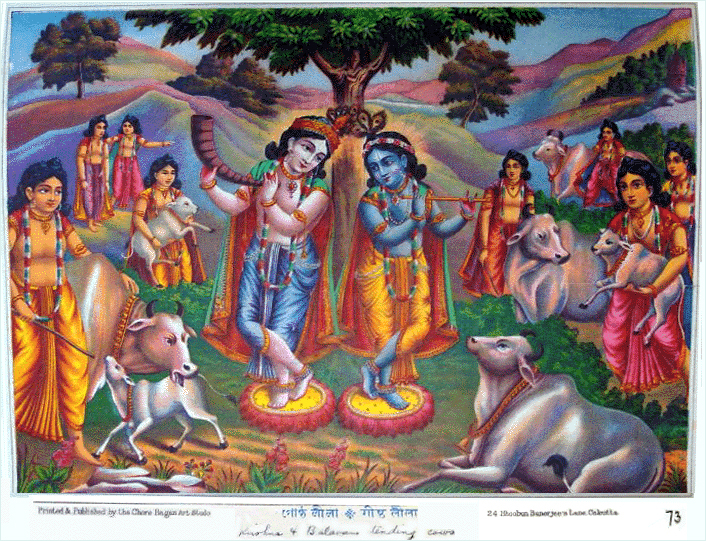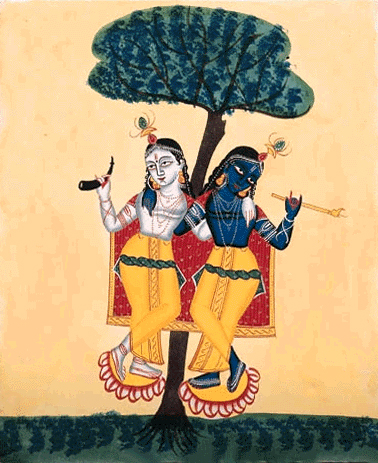
|
|
|
|
BY: SUN STAFF

Krishna and Balaram Tending Cows Apr 01, 2011 — CANADA (SUN) — A study of the historical, spiritual and cultural elements of Vedic design. Our next Chore Bagan lithograph in the series is another image of Lord Krsna and Balaram, entitled "Krishna & Balaram tending cows". Like yesterday's example of the divine Brothers, this plate, number 73, was printed at Chore Bagan's press at 24 Bhoobun Banerjees Lane in Calcutta. While this lithograph is similar in many ways to the print featured yesterday, there are also a number of interesting differences between the two. In today's print, the artist has again used brilliant colors for the forefront figures, but a much more subtle background landscape, although still creating a rainbow effect. The layers of color in the background have the quality of watercolors or pastels, while the figures in the forefront are the sort of crisp, sharply defined images more typically found in Chore Bagan's chromolithographs. The overall effect is wonderful, however, as the background offers a striking contrast that gives the scene an ethereal mood. Krsna and Balaram are again at the center of the landscape under the kadamba tree, but this time They are in the company of numerous gopas, gopis, and cows. While they are standing on the same sort of lotus pedestals and holding the same paraphernalia as in yesterday's image, this time Their clothing is a bit less opulently colored and Their headpieces are no longer matching. The standing posture of Krsna and Balarama is also different in today's print. This time, the Brothers are each crossing an outer leg, raised heels point inward. While there may well be some iconographic meaning behind the two different postures in these prints, we do not have knowledge of it. We do note, however, that from a strictly artistic standpoint, the pose used in today's print creates a different visual effect. In yesterday's example, the artist employed several techniques to create a strong center focal point on Their Lordships, e.g., the background perspective, crossed cowherding staffs, and body pose. In today's print we have a larger scene, and many more personalities are accommodated on the canvas. By standing with Their outer feet crossed inwards, Krsna and Balarama create a pose that is more squared, which has the effect of opening the view outwards, towards the rest of the scene.

Krishna and Balaram, Kalighat Painting As we've mentioned in previous segments, the era of printmaking in which Chore Bagan Art Studio became prominent was late 1800's, Calcutta, where it was preceded by another important Calcutta art school – Kalighat painting. The Kalighat style flourished as an inexpensive art form that the common man with little money could afford to purchase at the bazaar and take home for decoration. As we can see in the image of Krsna and Balaram above, the Kalighat style, rendered in watercolors and usually on inexpensive paper, is a simple two-dimensional style. Although the colors were often bright, reminiscent of tempera water paints (like those used by children), the drawings were imprecise and casual, like many folk art styles are. Obviously, we see a huge difference when comparing the Kalighats to the Chore Bagan chromolithographs, and these differences are not simply in technique. In the following description of the transition between the Kalighat and later art schools in Bengal, the author provides an interesting explanation for both the technical differences and the social influences that helped determine the content of these artworks. "Appropriating Realism: the transformation of popular visual iconography in late-nineteenth-century Calcutta" by K. Mukherjee (2006): Kalighat paintings and Battala engravings "The transformation that marked the popular visual world [of Calcutta printmaking] becomes especially clear if one begins with the genre of the bazaar art of Kalighat paintings, which lay outside the purview of Western tastes and influences and continued to flourish with its own variety of traditional themes and style. The development of Calcutta as an urban metropolis, with its increasing popularity as a centre of national and international trade, and the emergence of the Kalighat temple as an important centre of pilgrimage witnessed a massive influx of tourists, traders and pilgrims who desired easily portable mementoes to carry back home. This demand was fulfilled mainly by the Kalighat painters, who set up small shop-studios mainly around the temple and adopted a new form of visual representation quite distinct from their earlier practices of painting narrative scrolls or fashioning clay figurines (Jain 1999:13). While working under the heavy pressure of market demands, they developed a distinct style in which the speed of production and the agility of lines played an important role. The wide popularity and circulation of Kalighat paintings gave these images "an accepted position as the main art form of the natives in colonial Calcutta" (Guha-Thakurta 1992:18) and they were known as the popular bazaar art of nineteenth-century Calcutta. While exploring the transitional moment in local art practices, one sees that this bazaar art responded in its own way to the new visual vocabulary which existed around it in the early middle years of the nineteenth century. What Kalighat painting represented was one kind of alternative, nonrealistic tradition of picture production with its notion of flatness, its use of watercolour and its shift from continuous scrolls to single-frame images. While continuing to work within a traditional non-naturalistic, two-dimensional style, the Kalighat artists did confront and respond to other stylistic challenges that were products of the changing times. Perhaps it would not be wrong to say that through shading and a sense of volume, these bazaar painters were responding in their own way to the new category of realism that posed a visual challenge to them. Within the shifting realities of the social and cultural space of nineteenth-century Calcutta, the popular genre of Kalighat painting thematically liberated itself from the narrow precincts of normative religious iconography, and began to churn out images of the foppish babu, the bibi, seductive courtesans, contemporary social scandals such as the Mohanta-Elokeshi episode (Guha-Thakurta 1992:22), (1) and the icons of theatre heroines and actresses (Jain 1999:97)." Given that the academic perspective shared here by Mukherjee is not presented in a Vaisnava context, we cannot be surprised to find a description like this one – that "Kalighat painting thematically liberated itself from the narrow precincts of normative religious iconography". In fact, it was the opposite of 'liberation'. Rather, the Kalighat school devolved into the realm of mundane social and political themes, and even into some rather scandalous sexual themes. We find Kalighat examples where the deities (e.g., demigods like Shiva) were depicted not only in non-traditional, but in quite offensive ways by artists who took liberties in replacing transcendental elements with the mundane. Not only was the artistic printmaking style of presses like Chore Bagan superior, thus quickly eclipsing the Kalighats, but history shows that the Kalighat style essentially died in its tracks. This is evidenced by the fact that many generations of artists came after Chore Bagan, faithfully reproducing with the same religious sentiments scenes like Krsna and Balaram under the kadamba tree with Their cows and associates. On the other hand, we see no examples of art schools, and rarely even individual artists, who continued to develop new works in the Kalighat style. The Kalighat became as temporary as the fleeting mundane subjects it promoted, and it essentially disappeared from view.
| |